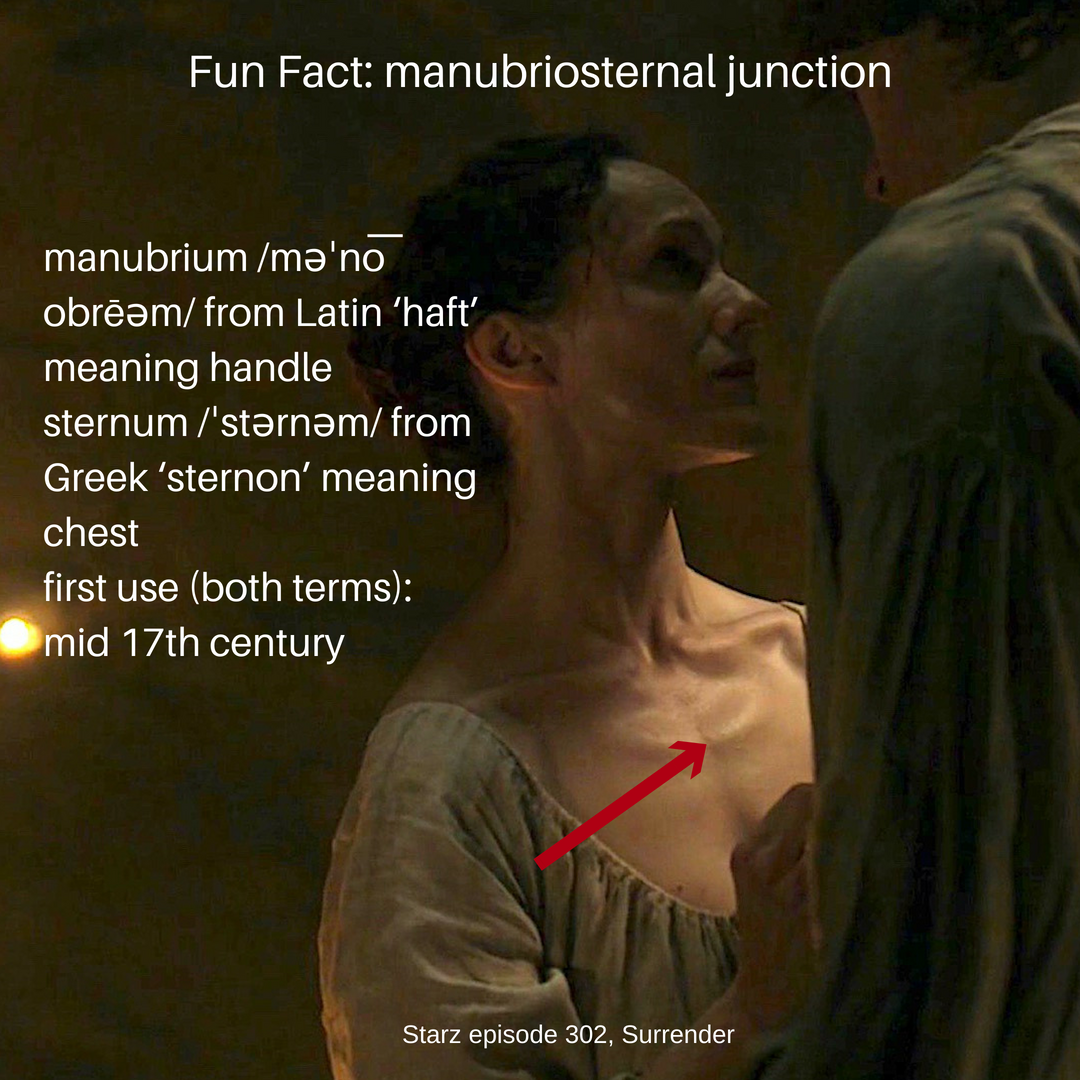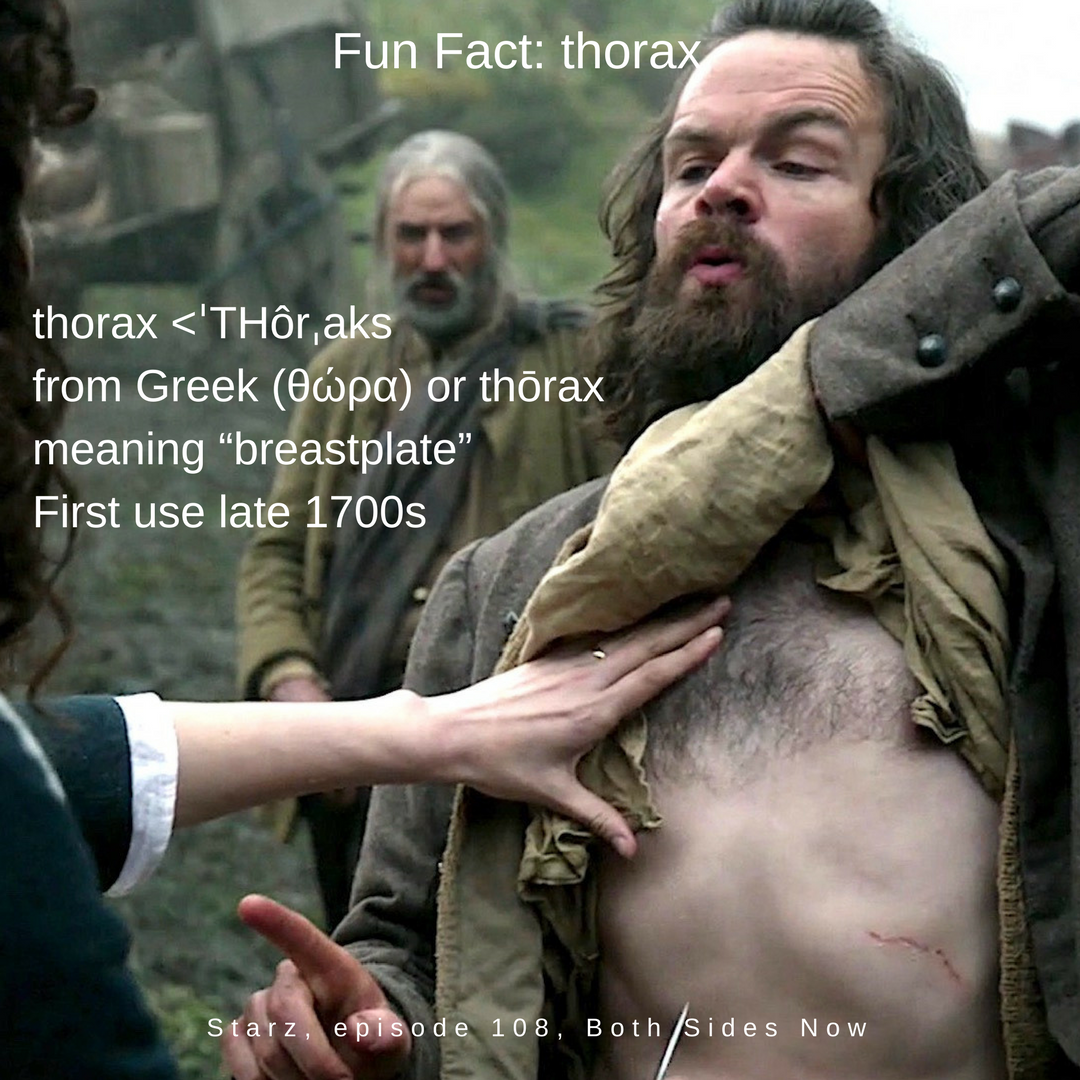
Anatomy def: Manubriosternal junction is a prominent joint between manubrium and body of the sternum (breastbone).
Outlander def: Wee Mary MacNab’s chest mound, sweetly straining toward the Dunbonnet. Surrender, Jamie! She kens they both need “this.” 😉
Learn about the manubriosternal junction in Anatomy Lesson #15, Crouching Grants – Hidden Dagger.
An adult sternum has three parts:
- manubrium (top)
- body (middle; a.k.a. gladiolus)
- xyphoid process (tip)
These parts are typically fused into a single, elongated bony structure in adults. Notably, the juncture between manubrium and body forms an elevated bump, the manubriosternal junction.
As this word is a real mouthful, many anatomists and clinicians use the term sternal angle, angle of Louis, or sternal angle of Louis, to supplant manubriosternal junction. (Why use one name when three will do?) <G> And, some anatomists push the envelop further, preferring the term, sternomanubrial joint. So many terms, so little time. Gah!
Taking an easier route, the sternal angle of Louis is a splendid topographical feature because it is easily palpated! It is the site where costal cartilages of the second ribs attach to the sternum. The T4 – T5 intervertebral disc also lies at this level. And, that is not all. This angle is used to locate or define some 15 (!!!) clinically significant structures and/or compartments of the chest. A useful example: starting at the second ribs, a practitioner can count intercostal (between ribs) spaces to locate organs and evaluate normal anatomy. Lots of splendid stuff going on here!
Try this: Place your fingers at the top of your chest in the small bony divot (suprasternal notch); this marks the top of the manubrium. Run fingers downward about 2” or 5 cm and feel the raised knob of bone? This is your sternal angle of Louis. Run fingers to each side – these are your second ribs and their costal cartilages. Feel them? Yay!
Here’s a useful hint: If you avoid heavy necklaces because they give you neck pain, choose one that sits above the sternal angle. This way, manubrium and clavicles help support the weight of the piece, easing pull on the neck.
Read about the sternum in Voyager book. Herself conjured this scene between Dr. Claire Randall and a dying Scottish patient (not filmed in S3):
“I have been thinking,” Graham announced. The sound of his voice echoed tinnily through the earpieces of my stethoscope. “Have you?” I said. “Well, don’t do it out loud ’til I’ve finished here, that’s a good lad.”
He gave a brief snort of laughter, but lay quietly as I auscultated his chest, moving the disc of the stethoscope swiftly from ribs to sternum. “All right,” I said at last, slipping the tubes out of my ears and letting them fall over my shoulders. “What have you been thinking about?”
“Killing myself.”
Whoa! Best read the book to find out what happens to Graham (and Claire)!
See Mary’s sternal angle (red arrow) in Starz episode 302, Surrender. Sweet, sweet Mary is so very slender, her sternal angle of Louis with its curved 2nd ribs and costal cartilages are plain as cave light. Way to rock it, Mary! Ye are a bonny lass!
The deeply grateful,
Outlander Anatomist
Follow me on:
- Twitter @OutLandAnatomy
- Join my Facebook Group: OutlandishAnatomyLessons
- Instagram: @outlanderanatomy
- Tumblr: @outlanderanatomy
- Youtube: Outlander Anatomy
Photo credit: Starz episode 302, Surrender

